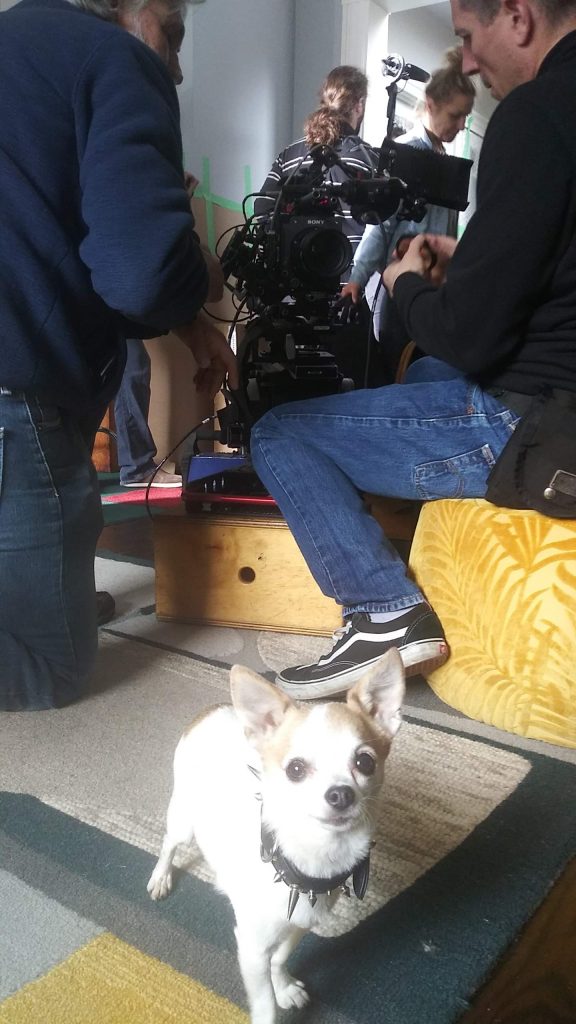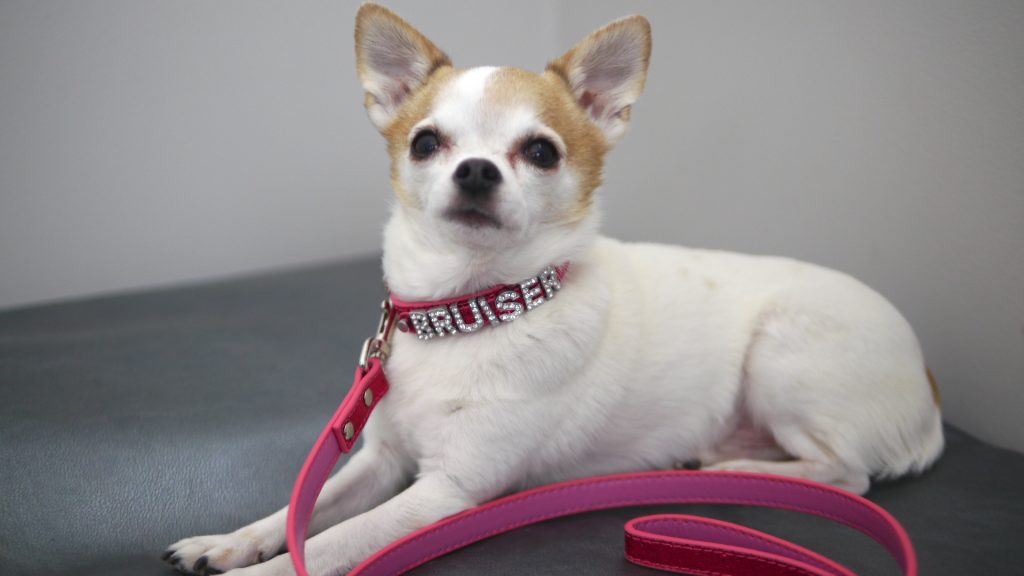One thing leads to another – hear that ear worm? It seems McGee is singing the tune these days. From a stint as talking dog Bruiser in Legally Blonde to a yippy dog gig as Brutus in a big TV commercial, that’s his star life of late!
My Dog in Commercials
This is some of what we learned from our dogs in commercials experience…
Animal wrangling is hard
Like really hard. McGee was the talent, I was the handler. We were accountable to the wrangler, who was hired by the production company, who work with the ad agency who are accountable to the client, who have representatives on set. Not only does the wrangler manage the talent and the handler, but he (in this case) manages all the “suggestions” and requirements of all those folks upstream. That’s a heck of a lot of charm, diligence, tact and diplomacy required. Never mind being savvy and compassionate towards the animals. McGee was joined by a particularly calm pigeon for one of the scenes. Huge kudos to Paul Rutledge and his colleagues at Action Specialties Equine Enterprises who got us through our neophyte experience with the utmost grace.

You will not have enough
For a newbie to this kind of commercial shoot, McGee and I both, no matter how many tricks, techniques and food / toy / treat rewards you have brought, it likely won’t be enough. By the time the production is 5 or 6 hours into the shoot, union overtime is looming, the equipment trucks have to be loaded and off the street by 11pm, and the dog doesn’t have even a tiny peep left in him to give, nothing is enough.
Animals are not like humans. They really do not understand budgets and permits and lighting and sound and camera angles and such. They just try their best to understand what the goofy humans are asking them to do. If they don’t understand, they can’t deliver.
Today the day after I see my error as dog trainer and handler. Under time and performance pressure, its important to think like a dog. Even though the suggestions for what may work to get the dog barking are coming fast and heavy from colleagues on set.
For instance, rather than cuing him to speak on command with hand and voice in front of him, or me stepping out of sight and actor cueing as we did for stage, the production folks asked me to both step out of sight and cue McGee with voice only, which he has never done before. Not surprisingly, it got us no results.
Rather I may have got down with him and instructed him to bark AT something. Something moving and exciting enough to merit attention. That is to say, one of his jobs at home (he thinks) is to let me know, i.e. bark, if there is a scary stranger outside. That’s what he already knows and understands. We got stuck on asking him to bark using means for which he had no understanding. We did not bend our minds far enough to other means using dog psychology that might have worked, especially as doggy energy got harder to elicit.
Stage Vs Screen
Prep for Legally Blonde the stage play involved a script, which we had in advance, then weeks of rehearsals, then an all or nothing moment in front of hundreds of people. Tough enough. For the most part that prep was done not only behind the scenes but at home where McGee and I worked out best practices.
For this screen gig, we were a last minute substitute. Apparently the storyboard changed at the last minute. As I understand it, the role of a big dog already cast became a role for a small dog recruited via public posting.

The last minute storyboard change called for a Pomeranian. McGee the Chi was a back up option, should the Pom not work out for whatever reason. We did not know if we would be called upon until cameras rolled a couple hours after call time.
Though McGee had the chops for performing a “speak” on cue, he typically gave it his all in one go live on stage. For the screen, he had to give it his all over and over and over. That’s because the camera needs to catch the action from various angles and with other actors – human and animals – also involved. Unfortunately we did not have access to the script or storyboard, even when we got to set. Part of that may be based on the competitive nature of corporate advertising – client does not want leaks before air date. After all, we are the non-union folks on set. So it was tough, as McGee’s handler, to know how to spend the energy he did have over the time period and the number of takes ultimately required. This is a very good thing to have learned should we ever have cause to do another such gig.
Another thing learned … one will not be able to sleep until 3am even though one got home at 12:30am having started at 3pm, due to dwelling on all the things you *could* have tried to have dog do all the barks in all the scenes and all the takes for which the storyboard called. D’oh!

Mid-shoot, about 5pm 
Almost end of shoot, 10pm
Big Money Makes For Big Asks
Having dozens of complete strangers watch you go looney trying to make your dog bark feels more revealing than a porno.
It was of course a union shoot. Which means everyone on that set, all 100+ of them, knew their job and how to do it. Its daunting and humbling to be in this company of professionals. Even though one of my prior careers was in the tv and film industry, never did I come close to the scale of production that is the norm for producing commercials.
We did our best to rise to the occasion, my little five pound dog and I. We had some great moments, and we had some flat ones. Tess Hardy, partner to Paul Rutledge of Action Specialties Equine Enterprises gave us next day feedback:
Paul thinks they got enough to be happy with. It can be a lot tougher than people think and training aside the animal’s temperament is key a lot of the time. Its a harder job than people think, but Paul has 30 years as stuntman, stunt coordinator and wrangler so he is pretty good at getting what productions need.
– Tess Hardy

So next time you see a cute baby creature in a television ad, take a pause and think about the hours and hours spent to get those pristine seconds of performance magic. We’ll be sharing this one as soon as they let us.

